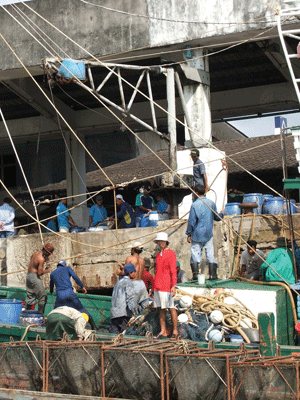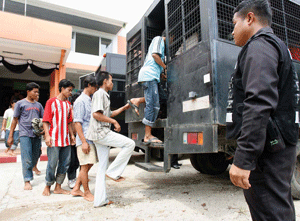
| By VIOLET CHO / MAHACHAI, BANGKOK | MAY, 2008 - VOLUME 16 NO.5 |
The tragic deaths of 54 Burmese migrant workers highlight once again the hazards of working illegally abroad
THERE were 10 men lying beside me in the back of a pickup truck. Our bodies were covered with a thick plastic sheet and it was extremely hot. I couldn’t see a thing. I could only hear the sound of cars and trucks going by,” recalled Yan Naing Htun, a migrant worker who came to Thailand from Burma eight years ago, when he was just 10 years old.
Yan Naing Htun said he left the Burmese border town of Myawaddy after his father, who raised him and his sister alone, died of malaria. Accompanied by a close friend of his father, he made the journey to Bangkok because he had no way to support himself in Burma.
 |
| Burmese migrant workers take the lowest paying and most dangerous jobs in Thailand. (Photo: The Irrawaddy) |
He still vividly remembers the terror he felt when he was smuggled into Thailand—the most popular destination for the millions of Burmese who are forced to look abroad for some means of making a living. “I was so afraid of being arrested that I tried to stay perfectly still under the plastic sheet,” he said.
Even after completing his journey, Yan Naing Htun soon learned that in Thailand there are few safe places for an illegal immigrant. Mahachai may be home to tens of thousands of Burmese workers, but there is little safety in numbers, as they are still vulnerable to gangs, harassment by police and workplace exploitation.
But that doesn’t prevent a constant influx of Burmese workers into the area. According to Somporn Sakaew, the director of the Mahachai-based Labor Rights Promotion Network, about 100 Burmese, including children, sneak into Mahachai every night to find jobs. “They take so many risks to come and work in Thailand,” he said.
 |
| Burmese migrant workers are frequently rounded up and deported. (Photo: Reuters) |
Yan Naing Htun could be considered lucky. He makes enough money to send part of his income back to Burma to help support his sister and her family. His biggest regret is that he never received an education—he cannot read or write, even in his native Mon language.
“I always dreamed of going to school, but when I consider my age, I feel ashamed,” the slightly built 18-year-old said with a shy smile. “I don’t like to think about it anymore.”
Yan Naing Htun’s situation may be about as good as it gets for an uneducated migrant worker in Thailand. For many others, the worst fears of the countless migrants who enter the country through border towns such as Mae Sot, Mae Sai, Mae Hong Son and Ranong—estimated at between one and two million—are all too often realized, sometimes with tragic consequences.
On April 9, a container truck carrying 121 migrant workers from the Burmese border town of Kawthaung was found abandoned in Thailand’s neighboring Ranong Province. Inside, along with 67 survivors, were the bodies of 54 men, women and children who had suffocated because the driver of the truck had failed to properly ventilate the container. The truck was en route to Phuket, a popular resort island with a booming tourism-based economy.
Aung Saw Shwe was one of the survivors of the horrific incident. An ethnic Arakanese from western Burma, he said that he had hoped to find work on a construction site in Phuket, where he could expect to make about 200 baht a day. This was much more than he was earning at his previous job at a fish processing plant in Ranong and enough to allow him to send some money back home.
“Luck is not on our side,” he said. “We left Burma because of the poverty there, but now this has happened.”
Fortune rarely favors Burmese workers in Thailand, as they must run a daunting gauntlet of obstacles from the moment they enter the country. This includes not only the smothering discomfort of being packed into tiny spaces as they are being smuggled into the country, but also a host of workplace hazards that few Thais would be willing to accept. And then there is the constant menace of employers who do not pay and corrupt officials who demand bribes. When disaster strikes, it comes as no surprise, but only confirms the magnitude of the risks illegal migrants must take when they leave the certainty of economic hardship at home for the possibility of a marginally better life abroad.
This was not the first time that large numbers of Burmese migrants had died while seeking jobs in Thailand. In March 2002, the bodies of 13 Burmese, including children and teenagers, were found in a garbage dump in the northeastern province of Prachinburi. Police suspected that they had suffocated while being transported across the country.
The December 2004 tsunami, which struck some of Thailand’s most popular tourist areas, including Phuket and neighboring Phang Nga Province, also took an enormous toll on the country’s Burmese migrant community. Rights groups believe that most of the 1,320 unidentified victims in Phang Nga, where some 4,224 people died in the disaster, were undocumented Burmese workers. Meanwhile, those who survived were left jobless and without government assistance.
Although nature and criminal neglect have both played a major role in reducing many migrants’ lives to unimaginable depths of misery, most observers say that the real culprit is Thailand’s migrant policy.
In Burma, the ruling junta has commandeered the country’s economy for its own benefit, leaving millions of Burmese to fend for themselves in an endless struggle against destitution. But critics say Thailand’s migrant-labor policy has been equally self-serving, ignoring the rights of foreign workers while favoring powerful commercial interests that are often linked to high-ranking government officials.
Another factor driving Thailand’s handling of the Burmese migrant issue is Bangkok’s desire to foster favorable ties with the regime in Naypyidaw. The poverty of its people notwithstanding, Burma possesses considerable natural wealth, and Bangkok has consistently overlooked its neighbor’s human rights record in exchange for access to its abundant resources. Thai leaders therefore tend to tread softly when addressing the root cause of the mass migration of Burmese into their country.
Ironically, friendly relations between the two governments have only served to create a more hostile environment for ordinary Burmese, at home as well as in their host country.
“Our hunger for Burma’s natural resources has caused the locals much suffering,” wrote political commentator Sunisuda Ekachai in the Bangkok Post, a leading English-language daily. She noted that the construction of pipelines which carry natural gas to Thailand and plans to build a mega-dam on the Salween River to help meet Thai energy needs have resulted in various forms of state-sponsored violence against ethnic minorities living in affected areas, forcing many across the border, either as refugees or as dispossessed farmers seeking work as unskilled laborers.
In Thailand, Burmese migrants are viewed unsympathetically by the general public and as a nuisance by many officials who do not directly profit from their presence. Police routinely extort money from them under threat of arrest and deportation. But an insatiable demand for cheap labor in Thailand and a deepening economic crisis in Burma mean that migrants will continue to flow across the border, inviting further tragedy.
In the wake of the mass suffocation incident in Ranong, the International Labour Organization and local labor rights groups in Thailand called on the government to overhaul its immigration policy. Specifically, this would involve expanding the migrant registration system to give more Burmese and other foreign workers in Thailand legal status, reducing their reliance on crime syndicates to get them into the country.
Some, such as activist and former Thai senator Jon Ungphakorn, would go even further, urging the government to open Thailand’s borders to migrant workers from neighboring countries with very few restrictions. The only losers, he argues, would be the human-smuggling mafias.
In the absence of a realistic, forward-thinking migrant labor policy, however, the Thai authorities have fallen back on their standard practice of treating migrants as criminals. Less than two weeks after the deaths of the 54 migrants in Ranong captured international headlines, Thai newspapers reported that immigration police in Phuket had arrested 50 illegal migrants from Burma and were in the process of deporting them.
It remains unclear what will happen to the survivors of the Ranong incident, which has seriously tarnished Thailand’s international image and highlighted the plight of Burmese migrants. Most remain in detention, and some have even spoken with members of a delegation of Burmese officials, who were quick to blame the Thai authorities for the deaths.
In all probability, the situation of Burmese migrant workers in Thailand will continue largely unchanged once the media attention from this latest episode has blown over. For most migrants, this means slipping back into the shadows of Thai society, hoping to remain as unnoticed as they are unprotected.
For Aung Saw Shwe, who lived through the horrors of witnessing the suffocation of 54 fellow migrants, there is no question of turning back. “I don’t want to be smuggled again, but maybe I have no choice,” he said, adding that another attempt to get to Phuket may be the only option available to him.